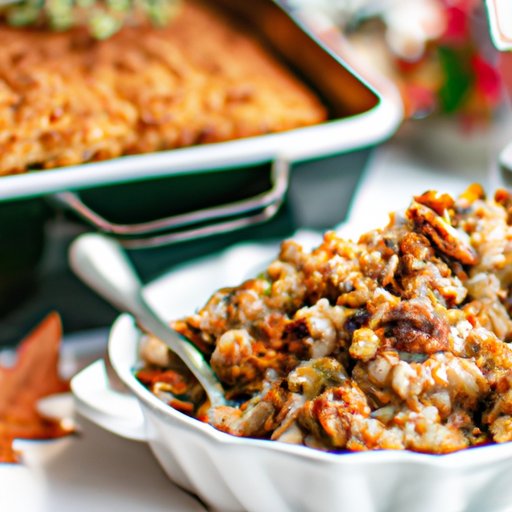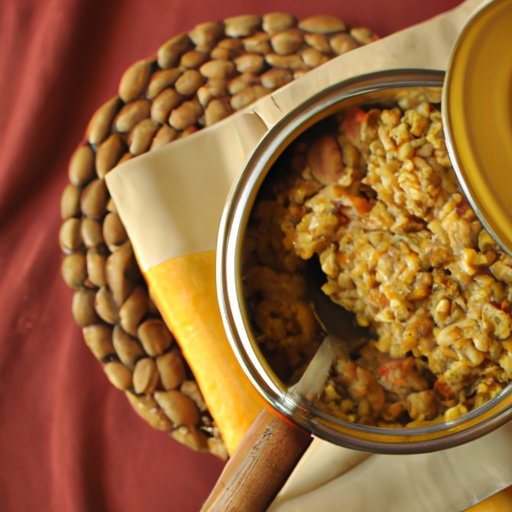
The Ultimate Guide to Making Stuffing: Tips and Tricks for Thanksgiving
Thanksgiving is a time for family, friends, and delicious food. One of the most iconic dishes on the table is stuffing, or dressing, depending on where you live. While it’s a classic recipe, there are many ways to make it unique to your taste. In this ultimate guide, we’ll cover everything from basic steps to unique ingredients and variations, gluten-free and vegetarian options, different cooking methods, and even how to turn leftover stuffing into new meals. By the end of this article, you’ll be equipped with all the tips and tricks to make the perfect stuffing for your Thanksgiving feast.
5 Easy Steps to Make the Perfect Stuffing for Thanksgiving
Before we get into the creative variations and unique ingredients, let’s cover the basic steps to making delicious stuffing. You’ll need bread, seasoning, vegetables, and liquid to create the base of your stuffing. Here are five easy steps to make the perfect stuffing:
- Cut your bread into pieces and let it dry out overnight or toast it in the oven until it’s crispy.
- Saute your vegetables, such as onions, celery, and carrots in butter until they’re soft.
- Add your seasonings, like sage, thyme, and rosemary, to the vegetables and cook for a minute or two.
- In a large bowl, mix your bread pieces with the vegetable mixture and add your liquid, such as chicken or vegetable broth, until the bread is moist but not soggy.
- Bake your stuffing in the oven at 375°F for 40-50 minutes, or until it’s golden brown on top and crispy around the edges.
To ensure that your stuffing turns out perfectly, here are some tips and tricks:
- Use day-old bread or toast your bread to ensure that it’s dry enough to absorb the liquid.
- Don’t overmix your stuffing, or it will become dense and heavy.
- Make sure your stuffing is moist but not soggy. Add more broth if necessary.
- Use fresh herbs for the best flavor.
- Let your stuffing cool for a few minutes before serving to let it set.
10 Unique Ingredients to Spice Up Your Stuffing Recipe
If you’re looking to take your stuffing to the next level, try incorporating some unique ingredients. Here are ten ingredients that will add some excitement to your stuffing recipe:
- Chestnuts: Roasted chestnuts provide a nutty and earthy flavor to stuffing.
- Cranberries: Dried or fresh cranberries add a tart and sweet flavor that complements savory stuffing.
- Pears: Sliced or diced pears add a sweet and juicy texture to stuffing.
- Fennel: Sautéed fennel adds a licorice-like flavor and fragrance to your stuffing.
- Chorizo: Cooked chorizo adds a smoky and spicy flavor to stuffing.
- Walnuts: Chopped walnuts provide a nutty and crunchy texture to stuffing.
- Mushrooms: Sautéed mushrooms add an earthy and meaty flavor that complements stuffing.
- Apples: Sliced or diced apples add a sweet and crisp texture to stuffing.
- Sourdough bread: Using sourdough bread adds a tangy and chewy texture to stuffing.
- Pecans: Chopped pecans provide a buttery and nutty flavor to stuffing.
When adding these ingredients to your stuffing, keep these tips in mind:
- Choose ingredients that complement each other and the flavor of the bread
- Use small amounts of new ingredients so they don’t overwhelm the dish
- Adjust your seasoning as needed to balance the flavors
Getting Creative with Stuffing: 5 Fun Variations to Try
If you’re tired of the same old stuffing every year, try one of these fun variations:
- Cornbread stuffing: Use cornbread instead of white bread for a sweeter and slightly crumbly texture.
- Sausage stuffing: Add cooked sausage to your stuffing for a meaty and savory flavor.
- Mushroom stuffing: Use mushrooms as the base for your stuffing instead of bread for a unique and vegetarian option.
- Crouton stuffing: Use croutons instead of bread for a crispy and crunchy texture.
- Bacon and apple stuffing: Add cooked bacon and diced apples to your stuffing for a sweet and savory combination.
When making these variations, keep these tips in mind:
- Adjust the seasoning and liquid to accommodate for the new ingredients
- Experiment with different variations until you find the one you like best
- Don’t be afraid to try new things!
Stuffing for All: Gluten-Free and Vegetarian Options
If you or your guests have dietary restrictions, don’t worry- you can still enjoy delicious stuffing. Here are some gluten-free and vegetarian stuffing options:
Gluten-free stuffing recipe:
- 1 loaf gluten-free bread, cut into pieces and dried out
- 2 cups gluten-free chicken or vegetable broth
- 2 tablespoons olive oil
- 1 onion, diced
- 2 stalks celery, diced
- 2 cloves garlic, minced
- 2 teaspoons dried sage
- 1 teaspoon dried thyme
- Salt and pepper to taste
- In a large skillet, heat the olive oil over medium heat. Add the onion and celery, and sauté until they’re tender and translucent.
- Add the garlic, herbs, salt, and pepper, and cook for another minute or two.
- In a large bowl, mix the bread pieces with the vegetable mixture and add the broth until the bread is moist but not soggy.
- Transfer the stuffing to a baking dish and bake at 375°F for 30-40 minutes or until it’s golden brown and crispy around the edges.
Vegetarian stuffing recipe:
- 1 loaf white bread, cut into pieces and dried out
- 2 cups vegetable broth
- 2 tablespoons butter
- 1 onion, diced
- 2 stalks celery, diced
- 2 cloves garlic, minced
- 2 teaspoons dried sage
- 1 teaspoon dried thyme
- Salt and pepper to taste
- In a large skillet, melt the butter over medium heat. Add the onion and celery, and sauté until they’re tender and translucent.
- Add the garlic, herbs, salt, and pepper, and cook for another minute or two.
- In a large bowl, mix the bread pieces with the vegetable mixture and add the broth until the bread is moist but not soggy.
- Transfer the stuffing to a baking dish and bake at 375°F for 30-40 minutes or until it’s golden brown and crispy around the edges.
When making these recipes, consider using gluten-free or vegetarian bread and broth for even more dietary friendliness.
From Stovetop to Slow Cooker: The Best Ways to Cook Your Stuffing
When it comes to cooking your stuffing, there are several ways to do it. Here are some pros and cons of different cooking methods:
- Stovetop: The stovetop method is quick and easy and allows you to adjust the seasoning and liquid as needed. However, it can be hard to get a crispy top, and you have to stir it frequently to prevent burning.
- Oven: The oven method provides a crispy top and edges, and you can make a large amount at once. However, it can be hard to get the temperature and cooking time just right, and it takes up valuable oven space.
- Slow cooker: The slow cooker method is hands-off and allows you to make your stuffing ahead of time. However, the texture can be soft and mushy, and you don’t get a crispy top or edges.
Regardless of which method you choose, follow these tips for the best results:
- Don’t overstuff the pan or slow cooker to ensure even cooking
- Adjust the seasoning and liquid as needed for the cooking method
- Cover the pan or slow cooker with foil to prevent burning
Leftover Makeover: Turning Thanksgiving Stuffing into Delicious Weeknight Meals
If you have leftover stuffing after Thanksgiving, don’t let it go to waste. Here are some delicious ways to repurpose your stuffing into new meals:
- Stuffing frittatas: Mix leftover stuffing with eggs and milk, pour into a skillet, and cook over medium heat until set.
- Stuffing-stuffed mushrooms: Spoon leftover stuffing into mushroom caps, sprinkle with cheese, and broil until golden brown.
- Stuffing waffles: Form leftover stuffing into waffles, and cook in a waffle iron until crispy.
- Stuffed squash: Cut butternut squash in half, scoop out the seeds, and stuff with leftover stuffing. Bake until the squash is tender.
- Stuffing meatballs: Mix leftover stuffing with ground meat and bake until cooked through.
When storing leftover stuffing, keep it in an airtight container in the fridge for up to four days. When reheating, add a splash of broth or water to moisten it up.
Conclusion
Congratulations, you’re now a stuffing expert! We’ve covered the basic steps and tips for making delicious stuffing, unique ingredients to spice it up, creative variations to try, gluten-free and vegetarian options, different cooking methods, and even how to turn leftovers into new meals. Take what you’ve learned and experiment to find the perfect stuffing recipe for your Thanksgiving feast.
